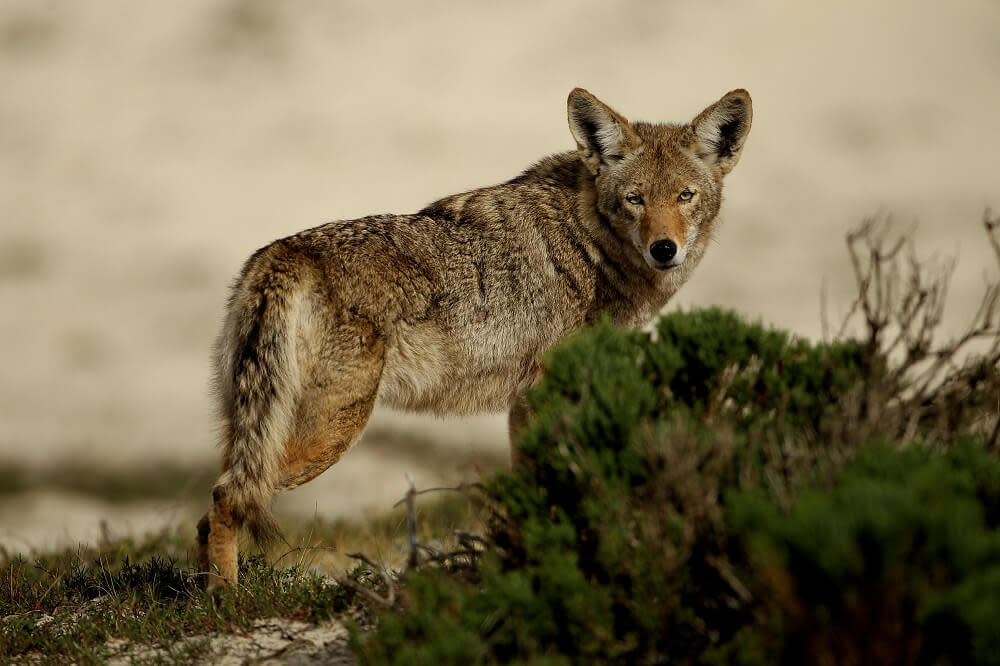Suspected wolf pack sighting in NV turns out to be coyotes

Not a wolf. (Photo by Ezra Shaw/Getty Images)
Policy, politics and progressive commentary
Wildlife managers in Nevada confirmed Monday that a possible wolf pack sighting north of Elko months earlier was, in fact, a pack of coyotes.
The Nevada Department of Wildlife reported the possible wolf pack sighting in March, prompting state biologists to collect DNA from two scats and hair samples nearby to confirm whether or not the pack sighted were indeed wolves.
However, results from two independent genetic labs completed this month found that the three suspected wolves spotted near Merritt Mountain were almost certainly coyotes.
Analysis of the hair, fecal, and urine samples collected along the suspected wolf tracks in the snow revealed with 99.9% certainty that the samples were from coyotes, according to NDOW.
“While initial observations indicated the possibility of wolves in the area, the DNA results of the samples collected indicated that these animals were, in fact, coyotes,” said NDOW Director Alan Jenne in a statement.
“We appreciate the diligence of our biologists, assisting laboratory personnel and the public’s cooperation throughout this process and we will continue to monitor the area for any indication of wolf presence,” he continued.
The possible wolf sighting was announced after a helicopter crew conducting an aerial moose survey spotted three suspected wolves traveling together. State biologists who conducted ground surveys immediately after the sighting believed the fresh tracks in the snow were consistent with wolves at the time.
The sighting could have been significant for Nevada, which has not confirmed a wolf pack in the state for more than a century. A single gray wolf was documented in Nevada west of the Black Rock Desert in 2016. Before then, the last confirmed Nevada sighting of a wolf was in 1922, near Elko County’s Gold Creek.
Jenne said he understood “the significance of such sightings and the importance of accurate identification.”
“NDOW will continue to work closely with state and federal agencies to uphold our mission of protecting Nevada’s ecosystems and wildlife while also maintaining transparency as a top priority in all our communications with the public,” Jenne said.
While Nevada has seen few confirmed wolf sightings in the last century, surrounding states have significant growing gray wolf populations. Idaho’s gray wolf population was estimated at 1,337 wolves in 2022, 37% higher than the original recovery goal for the animals, according to Idaho’s Department of Fish and Game.
The Oregon Department of Fish and Wildlife in 2023 reported about 200 gray wolves in nearly 25 packs in the state. Oregon state biologists also warned that the gray wolf population may have reached its ecological limit in the eastern third of the state, and that packs would likely spread out to the west and south in greater numbers.
As of 2024, the California Department of Fish and Wildlife said there are six known packs of gray wolves in the state for a total of 45 adult wolves, juveniles, and pups.
Gray wolves once ranged across all of North America, including the western United States. But decades of government-sponsored predator control programs brought gray wolves to near extinction in the lower 48 States. By the time wolves were protected under the Endangered Species Act of 1973, only a few hundred remained in northeastern Minnesota, and on Isle Royale, Michigan, according to the U.S. Fish & Wildlife Service.
Amaroq Weiss, the senior wolf advocate at the conservation group Center for Biological Diversity, said it is important to understand that wolves are wide-ranging animals that often travel hundreds of miles seeking new territory and resources, and may cross into Nevada. Weiss also noted it isn’t uncommon for federally protected wolves to be mistaken for coyotes and killed.
“Dispersing wolves all too often get shot and killed by folks who mistakenly think what they are shooting is an enormous coyote, so it’s good to keep the public apprised there could be wolves – which are federally protected – in the area,” Weiss said.
The post Suspected wolf pack sighting in NV turns out to be coyotes appeared first on Nevada Current.

